With type 2 diabetes growing in epidemic numbers, productivity in the workforce suffers, as patients struggle to balance work with periods of sickness, bouts with hospitalization, multiple primary and specialist appointments, and the like. The increased need for medical attention and services that comes with a diagnosis of diabetes affects insurance premiums in countries without universal healthcare, and increases costs for countries that do provide national health insurance coverage.
From the Centers for Disease Control’s National Diabetes Statistical report, 2014, there are a total of 29.1 million people, which is 9.3 percent of the population in the US, who have diabetes. The CDC also reported a statistic of 8.1 million people with diabetes who are undiagnosed, which accounts for 27.8 percent of people with diabetes who do not know that they have it.
With the rise in Type 2 diabetes in the United States, expenditures have also gone through the roof. Total direct and indirect costs are an astronomical $230 billion. Breaking down that figure, we see that $176 billion of that is in direct medical costs. The medical costs for a patient with diabetes are 2.3 times higher than for a person without diabetes. The remainder, $69 billion, goes to indirect costs including disability, work loss, and early death.1
Contents
The fate of Obamacare (the Affordable Care Act) is uncertain

For more researched articles on diabetes see below:
“Repeal and replace,” is the message of the new administration. But replace with what? This is an excellent question, because just yesterday, Trump was quoted as saying, “Health insurance coverage for all.” Since universal healthcare is far from his party’s platform, it’s very hard to say what this new statement by the President Elect means.
If indeed pre-existing conditions will no longer be covered, a diagnosis of diabetes in the United States could become a death sentence. This may seem a harsh assessment, but may not be far off base. I have patients who are planning their funerals due to the likelihood of losing Obamacare and being unable to afford their insulin. Some have complaints that without insurance, their insulin would cost over $1,000 per month, and is simply unaffordable.
Conversely, if we get “Health Insurance Coverage for all,” as was mentioned by Mr. Trump just yesterday, a diagnosis of diabetes should be covered. However, just in glancing at the afternoon headline, I find “18 million Could Lose Insurance in a Year under Obamacare Repeal, Congressional Budget Office Says.” It’s all very confusing, and no way to know as of yet what will happen. We can only hope that our elected officials have our best interest in mind.
Prescription drug costs out of control

Moving into 2017, we find that CVS and Express Scripts, have greatly limited their formularies for diabetes medications, as we see coverage go away for such medications as Lantus, Bydureon, Byetta, and even insulins.
Below is a list of the medications that CVS Caremark will no longer cover for diabetes. But don’t worry. This list doesn’t discriminate against you because of your diabetes. There is a whole list of medications for other chronic conditions that won’t be covered, in case you are feeling like the “Lone Ranger.” Also, you won’t be alone if you have other private insurance or Obamacare. In total in 2017, 200 prescription drugs have been removed from pharmacy formularies, restricting coverage for a variety of conditions from diabetes to hepatitis.
Medications are replaced with generic or “bio-similar,” medications. Sometimes this is less than optimal, for various reasons. Many people claim they just don’t work the same way for them, or they experience adverse side effects with one medication versus the other. Notice that only one kind of test strips (OneTouch Brand) will be covered in 2017 by CVS Caremark . The Express Scripts list is equally disturbing, though not nearly as long as the CVS list of medications no longer approved for diabetes. While insurance companies may be helping their bottom line in costs for prescription medications, they are causing quite a few more problems for some patients with diabetes.2
| Med(s) that won’t be covered in 2017 | The substitution med(s) |
| NESINA
ONGLYZA KAZANO KOMBIGLYZE XR OSENI |
JANUVIA
TRADJENTA JANUMET JENTADUETO |
| BYDUREON and BYETTA | TRULICITY or VICTOZA |
| INVOKANA
INVOKAMET |
FARXIGA
JARDIANCE XIGDUO XR |
| APIDRA
HUMALOG 50/50 HUMALOG 75/25 HUMULIN 70/30 HUMULIN N HUMULIN R LANTUS AND TOUJEO |
NOVOLOG,
NOVOLOG 70/30 NOVOLIN 70/30 NOVOLIN N NOVOLIN R BASAGLAR LEVEMIR |
| ALL DIABETES TEST STRIPS except for the ONETOUCH brand | ONE TOUCH |
Fight to stay alive
No one should have to fight with the insurance company just to obtain needed medications to stay alive. However, with the rise in diabetes, and the rising costs of healthcare, here we are. Many patients end up frustrated when trying to convince their insurance company that they need a particular medication. Even if their very life depends upon it, they still may be in a losing battle with insurance companies who operate on profit and a bottom line. It’s sorry to say, that the bottom line is most often money, and people with diabetes are considered very expensive to cover.
Don’t like the Medtronic pump? Got United Healthcare? Too bad…
Another swift move by an insurance company this year includes United Healthcare’s refusal to cover any insulin pump except the Medtronic pump. All this restriction of treatment choice may be in an effort to negotiate lower drug pricing from US pharmaceutical companies. And they had better be trying to do just that. In the Senate last week, they shot down Senator Bernie Sander’s efforts to get Canadian drugs imported at cheaper prices, so it’s unlikely for that to come to fruition, at least not anytime soon.
Other countries and diabetes
There are 33 countries who offer National Healthcare of some sort. Many of these countries have also experienced a rise in diabetes. The United States is on that list, but considering the current state of uncertainty as to the fate of Obamacare (The Affordable Care Act), the future is up in the air as to whether or not the US will drop off the list. Since we have some data from 2016, we will take a look now at the United Kingdom and their diabetes statistics.
The United Kingdom and diabetes
The United Kingdom just released their Facts and Stats Report on diabetes in October, 2016. From the report, there are an estimated 4.5 million people living with diabetes in the United Kingdom. Of those, 3.5 million are diagnosed, with an estimated 1 million going undiagnosed. The United Kingdom has seen a rise in diabetes since 1996. Indeed the numbers have more than doubled from 1.4 million to almost 3.5 million.
Financially, diabetes has taken its toll on the United Kingdom. To give you an idea of the comparison, the current dollars to pounds ratio is 1 US dollar = 0.8135 British pounds.
In the United Kingdom, it is estimated that the National Healthcare System spends £10 billion for the direct medical costs of diabetes per year. Total costs, which include indirect costs, are currently at £23.7 billion and are expected to rise to £39.8 billion by the year 2035.
In the United Kingdom, people with diabetes account for more than double the hospitalization rate. Prescription costs in the United Kingdom were over £803 million for the year 2013/2014. This represents an increase in costs of 5.1 percent from 2012, which further attests to the rising costs of diabetes and diabetes prescriptions in the UK, and worldwide.3
Diabetes spends down 10 percent of the full National Healthcare budget in the UK. 80 percent of costs are from complications, such as cardiovascular disease, strokes, amputations, or kidney disease. In 20 years, the expenditures for diabetes are expected to reach 17 percent of the overall National Healthcare budget. Social care also comes at a high price. Post-amputation, for example, activities of daily living are very limited, and patients require assistance upon returning home.4
Further reading:
Worldwide perspective
Worldwide, we are seeing an increase in Type 2 diabetes that will certainly cause problems for people’s health, but also for the health of the community. Fiscal health is under fire, as expenditures for diabetes continue to rise. The best hope we have at curtailing medical costs, loss of productivity, and other expenses related to diabetes while waiting for a cure, is to push self-management education programs to teach people what they need to know in order to manage their disease. So diabetes has been affecting everyone with it's increasing cost and I hope this article helped you understand why.
TheDiabetesCouncil Article | Reviewed by Dr. Jerry Ramos MD on June 03, 2020
References
- https://www.cdc.gov/diabetes/data/statistics/2014statisticsreport.html
- http://www.bootcampforbetics.org/blog/insurers-heavily-restrict-diabetes-coverage-in-2017
- https://truecostblog.com/2009/08/09/countries-with-universal-healthcare-by-date/
- https://www.diabetes.org.uk/Documents/Diabetes%20UK%20Cost%20of%20Diabetes%20Report.pdf





